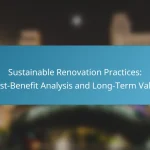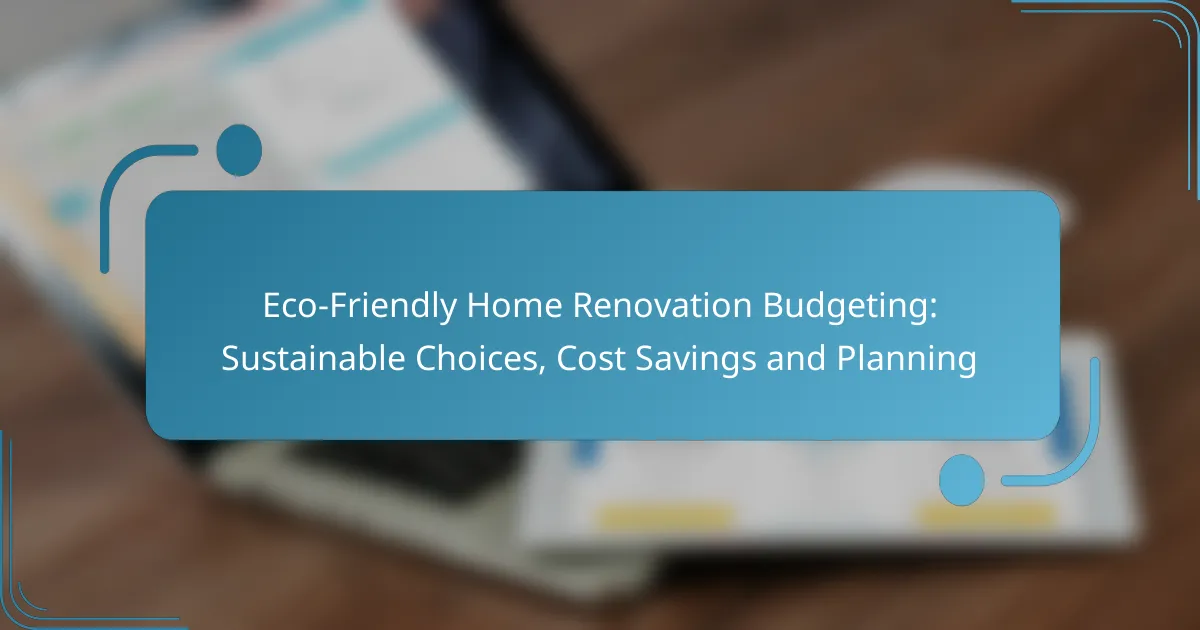Embarking on eco-friendly home renovations requires a strategic approach to budgeting that balances sustainable choices with financial considerations. By selecting durable, low-impact materials and energy-efficient upgrades, homeowners can not only reduce their environmental footprint but also enjoy long-term cost savings. Careful planning and awareness of potential tax incentives can further enhance the benefits of these green renovations.
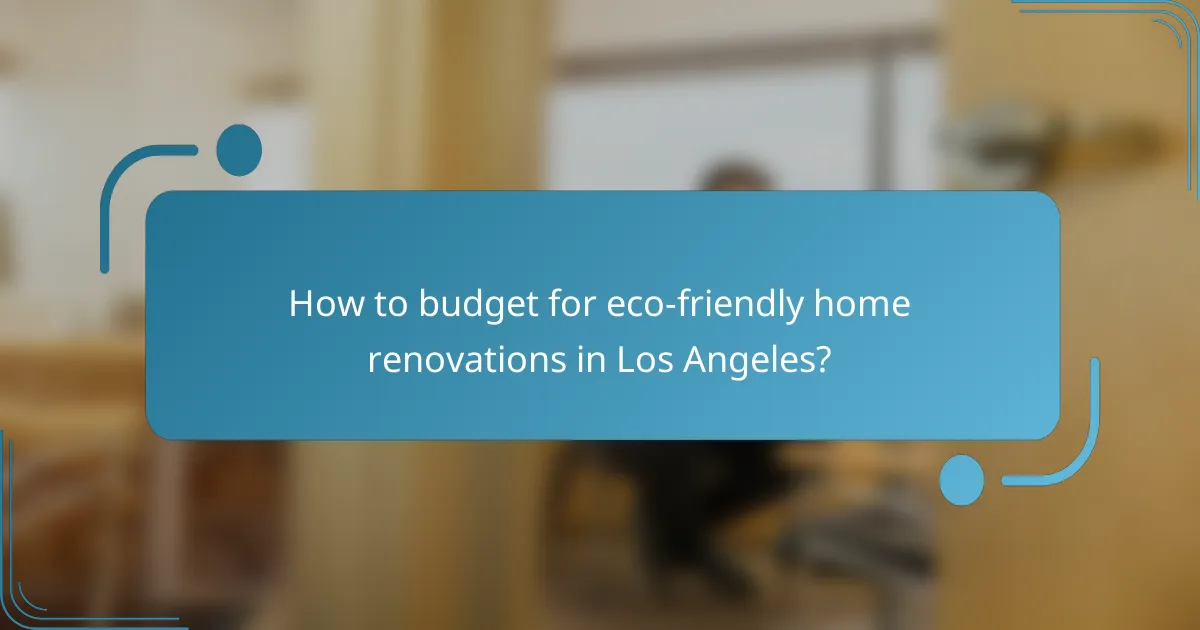
How to budget for eco-friendly home renovations in Los Angeles?
Budgeting for eco-friendly home renovations in Los Angeles involves understanding the costs associated with sustainable materials, energy-efficient upgrades, labor, and potential tax incentives. By planning carefully, homeowners can make informed choices that align with both their financial and environmental goals.
Estimate costs for sustainable materials
When estimating costs for sustainable materials, consider options like reclaimed wood, bamboo flooring, and recycled glass tiles. Prices can vary widely; for example, reclaimed wood may range from $5 to $15 per square foot, while bamboo can be found for $3 to $8 per square foot.
Additionally, look for local suppliers in Los Angeles that specialize in eco-friendly products, as they may offer competitive pricing or discounts for bulk purchases. Always compare prices and quality to ensure you’re getting the best value for your investment.
Consider energy-efficient upgrades
Energy-efficient upgrades can significantly reduce long-term costs and improve home comfort. Common upgrades include Energy Star-rated appliances, high-efficiency HVAC systems, and improved insulation. The initial investment for these upgrades can range from a few hundred to several thousand dollars, depending on the scope of the project.
For instance, upgrading to a high-efficiency furnace might cost between $3,000 and $5,000, but it can save homeowners hundreds on energy bills each year. Prioritize upgrades that offer the best return on investment and align with your renovation goals.
Account for labor and installation
Labor and installation costs can vary based on the complexity of the renovation and the expertise required. In Los Angeles, skilled labor for eco-friendly renovations might range from $50 to $150 per hour, depending on the contractor’s experience and the project’s demands.
To manage these costs effectively, obtain multiple quotes from contractors who specialize in sustainable renovations. This will help you gauge the market rate and ensure you are not overpaying for labor.
Identify potential tax incentives
Homeowners in Los Angeles may be eligible for various tax incentives when undertaking eco-friendly renovations. Federal and state programs often provide rebates or credits for energy-efficient upgrades, such as solar panel installations or energy-efficient windows.
Research current incentives through resources like the Database of State Incentives for Renewables & Efficiency (DSIRE) to understand what is available. These incentives can significantly offset renovation costs, making sustainable choices more financially viable.
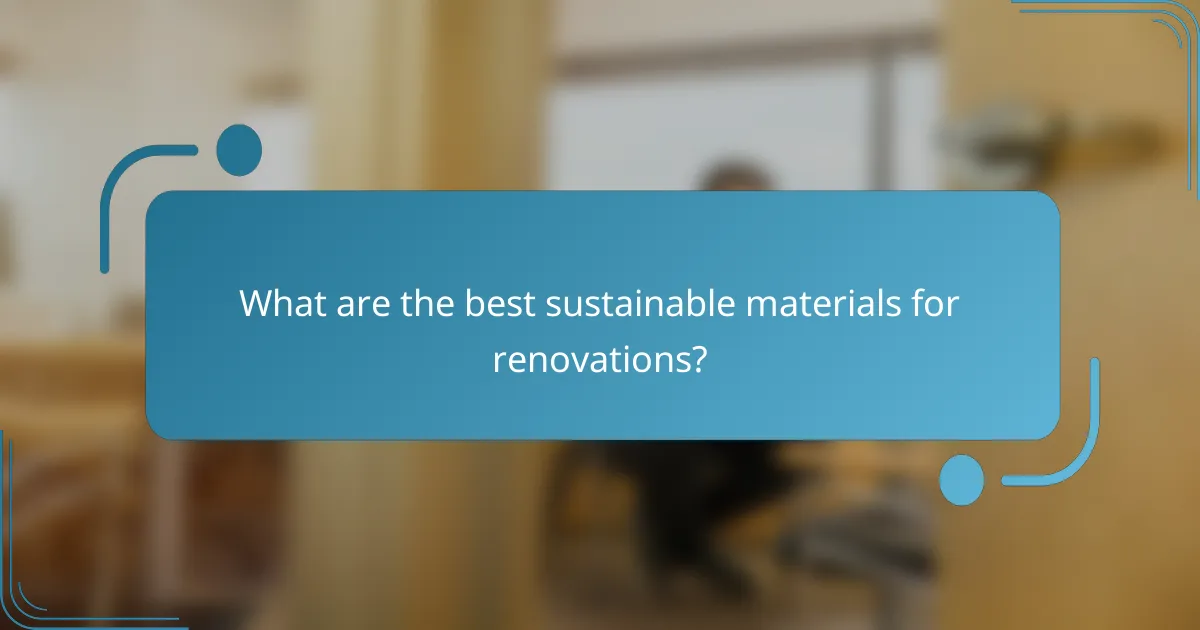
What are the best sustainable materials for renovations?
The best sustainable materials for renovations include options that minimize environmental impact while providing durability and aesthetic appeal. Choosing materials like recycled products, low-VOC paints, and energy-efficient windows can lead to both cost savings and a healthier living environment.
Recycled materials
Recycled materials are an excellent choice for eco-friendly renovations as they reduce waste and conserve natural resources. Common options include reclaimed wood, recycled metal, and repurposed bricks, which can add character and uniqueness to your home.
When selecting recycled materials, consider their source and quality. Look for products certified by reputable organizations to ensure they meet sustainability standards. Local suppliers may offer reclaimed materials at competitive prices, making them a cost-effective choice.
Low-VOC paints
Low-VOC (volatile organic compounds) paints are crucial for maintaining indoor air quality during renovations. These paints emit fewer harmful chemicals, making them safer for both occupants and the environment. They are available in a wide range of colors and finishes, allowing for creative flexibility.
When purchasing low-VOC paints, check for certifications like Green Seal or the EPA’s Safer Choice label. These indicators ensure that the products meet stringent environmental standards. Additionally, consider purchasing in bulk to save on costs while minimizing packaging waste.
Energy-efficient windows
Energy-efficient windows are vital for reducing energy consumption and enhancing comfort in your home. They are designed to minimize heat loss in winter and reduce heat gain in summer, which can lead to significant savings on heating and cooling costs over time.
When selecting energy-efficient windows, look for those with a high Energy Star rating or those that meet local energy efficiency codes. Double or triple glazing, low-emissivity (Low-E) coatings, and insulated frames are key features to consider. While the initial investment may be higher, the long-term savings on energy bills can make them a worthwhile expense.
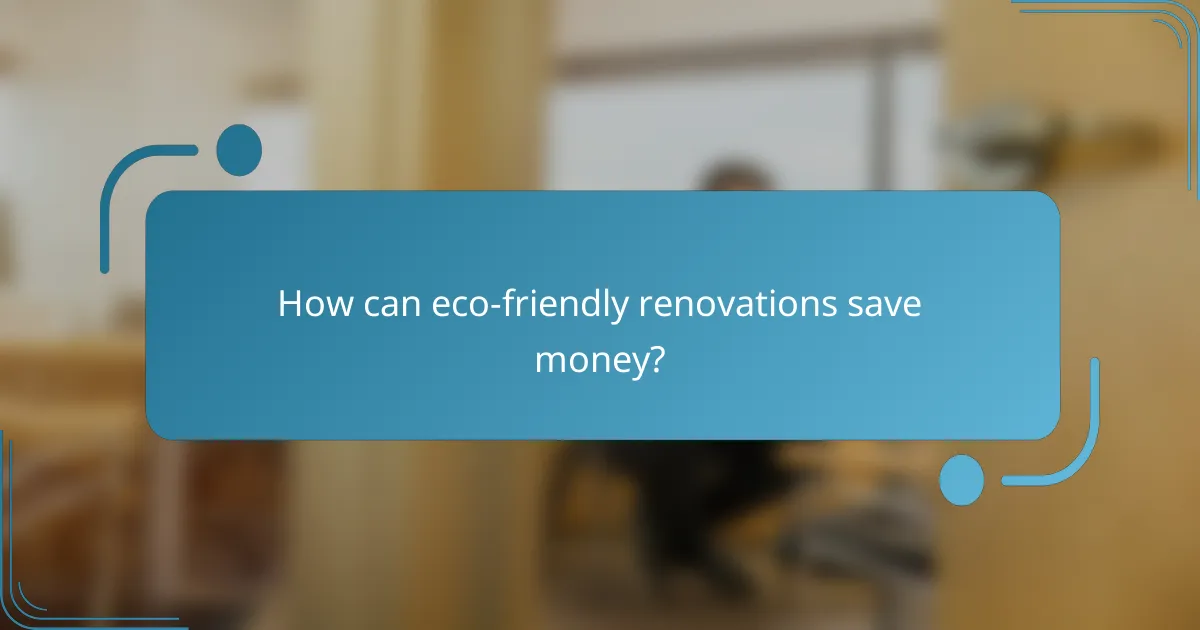
How can eco-friendly renovations save money?
Eco-friendly renovations can lead to significant cost savings by reducing utility expenses, increasing property value, and utilizing durable materials. These sustainable choices not only benefit the environment but also enhance your financial situation in the long run.
Lower utility bills
One of the most immediate financial benefits of eco-friendly renovations is the reduction in utility bills. Energy-efficient appliances, LED lighting, and improved insulation can lower electricity and heating costs by a noticeable margin. For example, homeowners may see reductions of 20-30% in their energy bills after implementing these upgrades.
To maximize savings, consider installing solar panels or energy-efficient windows, which can further decrease reliance on traditional energy sources. Additionally, many local governments offer rebates or tax incentives for energy-efficient upgrades, making these renovations even more affordable.
Increased home value
Eco-friendly renovations can significantly increase your home’s market value. Properties with energy-efficient features often attract more buyers and can sell for 5-15% more than similar homes without these upgrades. Features like solar panels, high-efficiency HVAC systems, and sustainable materials are particularly appealing in today’s real estate market.
When planning renovations, focus on improvements that are recognized for their sustainability, such as using reclaimed wood or low-VOC paints. These choices not only enhance aesthetics but also resonate with environmentally conscious buyers, making your home more desirable.
Long-term durability of materials
Investing in durable, eco-friendly materials can lead to long-term savings by reducing the need for frequent repairs or replacements. Materials such as bamboo flooring, recycled metal roofing, and fiber-cement siding are designed to withstand the elements and last longer than traditional options. This longevity translates to lower maintenance costs over time.
When selecting materials, prioritize those that are both sustainable and resilient. Research local suppliers who offer eco-friendly options and consider the lifecycle costs of materials, including their environmental impact and durability. This approach ensures that your renovations are not only cost-effective but also environmentally responsible.
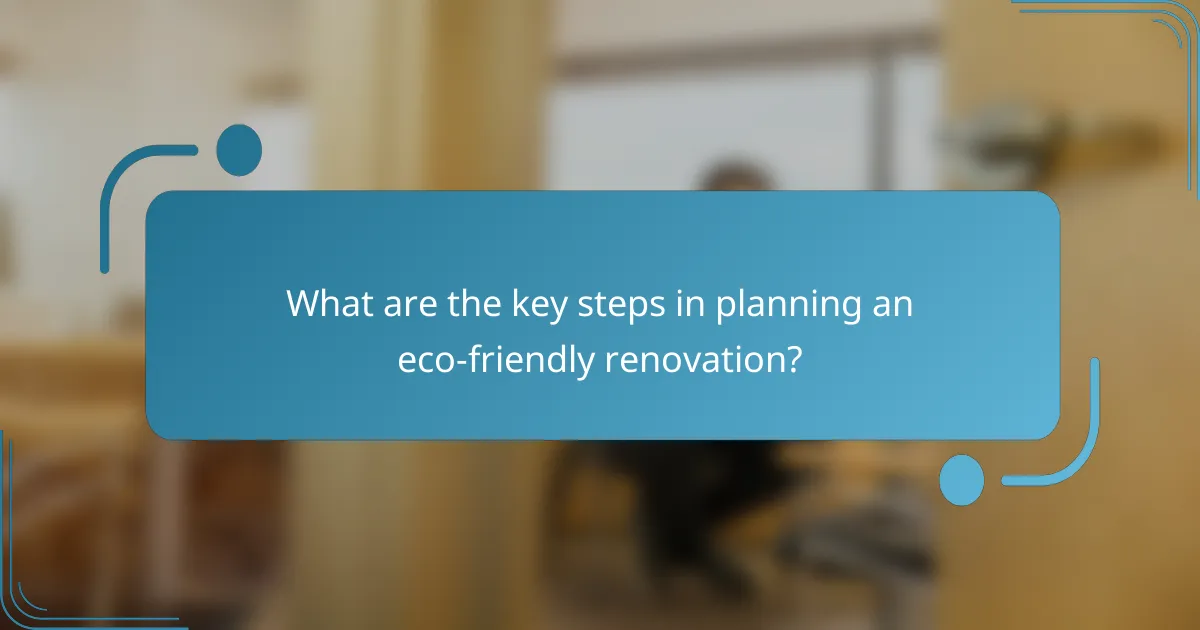
What are the key steps in planning an eco-friendly renovation?
Planning an eco-friendly renovation involves several essential steps that prioritize sustainability while managing costs. By conducting an energy audit, setting a clear budget, and hiring a green contractor, homeowners can make informed decisions that benefit both the environment and their finances.
Conduct an energy audit
An energy audit is a critical first step in identifying areas where your home can improve energy efficiency. This process typically involves assessing insulation, windows, heating and cooling systems, and appliances to pinpoint energy waste.
Homeowners can conduct a DIY audit or hire a professional auditor. A professional audit may cost a few hundred dollars but can reveal significant savings opportunities, such as upgrading to energy-efficient appliances or improving insulation.
Set a clear budget
Establishing a clear budget is essential for any renovation, especially when focusing on eco-friendly choices. Consider both upfront costs and long-term savings from energy-efficient upgrades. Aim for a budget that allows for sustainable materials and technologies, which may have higher initial costs but lower operational expenses.
When setting your budget, include a contingency of around 10-20% for unexpected expenses. This will help ensure that you can accommodate any necessary changes without derailing your financial plan.
Hire a green contractor
Choosing a contractor with experience in eco-friendly renovations can significantly impact the success of your project. A green contractor understands sustainable practices and can recommend materials and techniques that minimize environmental impact.
When selecting a contractor, look for certifications such as LEED (Leadership in Energy and Environmental Design) or similar local credentials. Request references and review past projects to ensure they align with your sustainability goals.
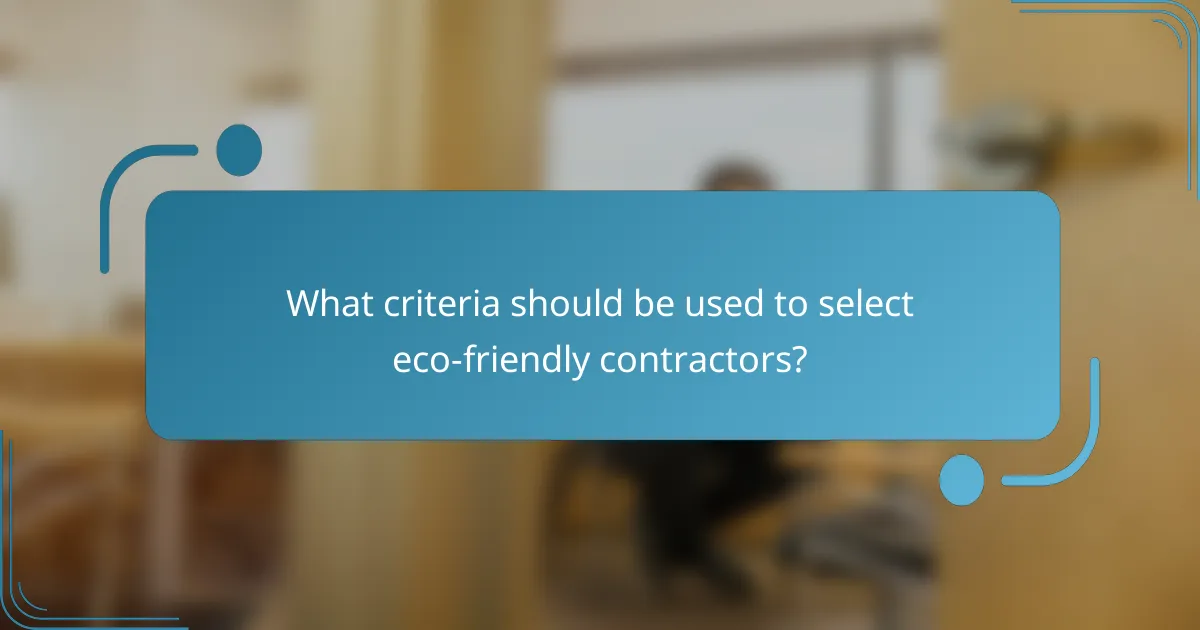
What criteria should be used to select eco-friendly contractors?
When selecting eco-friendly contractors, prioritize their experience with sustainable practices, relevant certifications, and their commitment to environmentally friendly materials and methods. This ensures that your renovation aligns with your sustainability goals while also adhering to industry standards.
Experience with sustainable practices
Contractors with a solid background in sustainable practices are more likely to deliver quality results that meet eco-friendly standards. Look for professionals who have completed projects focused on energy efficiency, waste reduction, and the use of renewable resources.
Ask potential contractors for examples of past projects that demonstrate their expertise in sustainable renovations. A good contractor should be able to provide references and showcase their ability to integrate eco-friendly solutions effectively.
Certifications in green building
Certifications are a reliable indicator of a contractor’s commitment to sustainable building practices. Look for credentials such as LEED (Leadership in Energy and Environmental Design), Green Globes, or local equivalents that validate their knowledge and adherence to green building standards.
These certifications often require contractors to stay updated on the latest sustainable technologies and practices, ensuring that they can offer the most effective solutions for your renovation. Verify their certifications and ask how they apply this knowledge in their work to ensure your project meets eco-friendly criteria.



